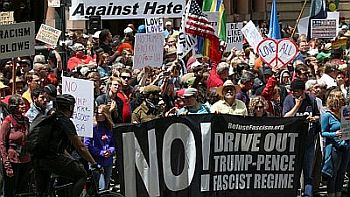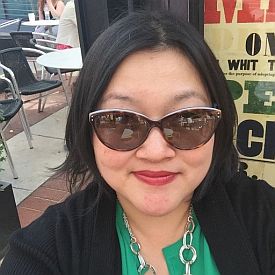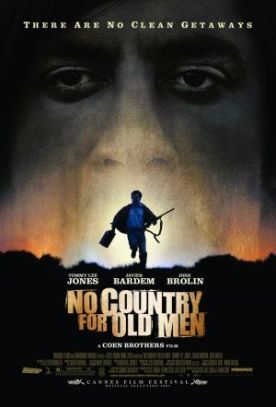Right side vs. white side
From The New CriterionAssociate Professor Dorothy Kim
It’s odd to be living, as I do, in Virginia, now that it has become the principal battleground in what Angelo Codevilla calls our “cold civil war” — as it once was in the hot one whose memory has lately become the cause of new strife. A few weeks ago, some local high school students decided to demonstrate against what, had any other president taken it, might have seemed the arcane but hardly controversial decision by President Trump to return the legal question raised by the Obama-era decree known as DACA (Deferred Action for Childhood Arrivals) to our national law-making body for resolution. The demonstrators naturally picked up, among their signs and chants, what had become a favorite topos of the Obama administration, and one only less popular than “that’s not who we are,” which the ex-president trotted out yet again in response to the DACA decision. They denounced the current president, that is, for being “on the wrong side of history.”
What a depressing thought, that the only thing these newly radicalized children know about history is that it has a right and a wrong side — and that their country has long been on the wrong one. For that is always the assumption behind the right-side-wrong-side conceit, an idea that would never have occurred to anyone who didn’t believe to a certainty that he himself was on the right side. Nor, for that matter, would it have occurred to anyone who had studied history from a non-ideological perspective. But, then, the kids will also no doubt have learned that there is no such thing as a non-ideological perspective. Those of us who simply wish to understand the past without, as we vainly imagine, any ideological pre-conceptions, are guilty of what has lately become the cardinal sin of nostalgia, which I guess counts as an ideology because it accepts those old-timey ideologues’ imputed but obviously false claims not to have been ideologues.
But if so what was their ideology? For that you may apply to black studies departments across the land who have in recent years outed it under the name of “whiteness.” Building on the work of Edward Baptist (The Half Has Never Been Told: Slavery and the Making of American Capitalism) and others to delegitimize the American republic, its Constitution and even its economy on account of the original sin of slavery, they have reduced slavery itself into a mere sub-category of the supposedly all-encompassing “whiteness” ideology. That is the real “system” that oppressed black people then and is still, supposedly, oppressing them now. “Whiteness is the most violent f***ing system to ever breathe!” said an enlightened but not en-whitened protestor at Evergreen State College in May.
In fact, if assistant professor Dorothy Kim of Vassar College is to be believed, the evil of whiteness even antedates the period in which people have been recorded as thinking of themselves as “white.” Professor Kim, who is a medievalist, thinks she has located the fons et origo of all this historical wrongness in the European Middle Ages. Not that that gets America off the hook, of course. “Medieval Studies,” she writes somewhat obscurely, “has become the historical belly of white nationalism and white supremacy.” By the magic of “intersectionality,” that is, she purports to find the vital and enduring connection between medieval concepts of differing sex roles, known to her jargon but to no actual medieval person as “heteropatriarchy,” and the white supremacy that (as she fondly imagines) is everywhere in the ascendant in America today.
It’s not surprising, of course, that these academic hijinks have been going on for years in the institutions of higher learning which the Virginia high school students will shortly be invited to bankrupt themselves in order to attend. But the real news out of Charlottesville, seat of the University of Virginia, is the extent to which this kind of ideological thinking has recently gone mainstream — with the help of the technique pioneered by communists in the 1930s of identifying anyone to the right of themselves as “fascists.” As the original believers in being (by way of Hegel and Marx) on the right side of history, the communists could not but feel the unassailability of their logic in identifying all those who were, ex hypothesi, on the wrong side with the unattractive faction who were their chief ideological opponents at the time and who were, not coincidentally, trying a similar technique against them.
Now such thinking has made one of its many comebacks with the self-described “antifa” brigades that showed up in Charlottesville in August, claiming the right to break up or shout down any political speech or meeting or demonstration by those with whom they disagree on the presumptive grounds that that disagreement must be tantamount to fascism. That’s what the “fa” in their name represents, after all. But it is no accident, comrades, that the media began to publicized these dubious activities only on an occasion when many of those whose demonstration they were trying to break up really were self-described white supremacists and neo-Nazis.
The latter had obtained by judicial order a permit for their march — as a demonstration of support for a Confederate monument in the city whose removal had been mooted — against the wishes of the local authorities, and when the black-masked antifa brigades showed up, without a permit, the local police stood aside while they attacked the marchers. One of the wrong-siders who was also, reportedly, a diagnosed schizophrenic drove his car into a crowd, killing a young woman and injuring several others. “Fascism” had finally proven itself to be as deadly, if not so widespread, as the antifas had claimed and thus justified their own violence against it. The antifa brand had arrived.
 |
Their violence against conservatives and Trump supporters since the election had not always been widely reported, but now the antifas and their media enablers could be more convincingly portrayed as being unambiguously on the right side of history. More importantly, given the media’s preoccupation over the past seven months, President Trump could be portrayed as being on the wrong side. Acting, perhaps, on the well-publicized discovery of Ta-Nehisi Coates that “his ideology is white supremacy” the media then turned to the President for a ritual denunciation of his presumed white supremacist allies.
In the course of giving it, however, and of explicitly condemning those whom he didn’t scruple to call “neo-Nazis and white nationalists,” he also gave it as his opinion that both blame and “good people” were to be found on both sides — pretty obviously, I would have thought, intending “both sides” to refer to the statue-removal issue, not history. Needless to say, I suppose, the media didn’t see it that way. I thought at the time, as presumably did others interested in the media’s long-vanished sense of fair play, that the President might have avoided the volcanic eruption of moral outrage which ensued by a different form of words, a more careful description of the thread of nuance on which he was attempting to tread, like a tightrope stretched between the violently self-righteous to either side of him. Something like this, perhaps:
Of course, I’m not in favor of white supremacism, let alone Naziism. But I am in favor of free speech, even for those with whom I disagree. Even for those whom I find repugnant. The Unite the Right protestors in Charlottesville were exercising their right to free speech and had a permit for their march. The left-wing protestors who set upon them with clubs and other weapons, had no permit and were trying to deny them their right to speak. They shouldn’t have been allowed to do that, and an inquiry into why the police did not stop them and protect the marchers is in order. There is obviously no excuse for the mentally unbalanced young man who killed a woman and injured others with his car, but that wicked act should not be allowed to blind us to the illegal attempts by others to deny free speech rights to those with whom they disagree.
On reflection, however, I doubt that it would have made any difference. The media would in any case have found a way to do what they always do and report his remarks, whatever they were, as if he had defended the “neo-Nazis and white nationalists” whom he had explicitly condemned. The media were already certain that Trump was a Nazi, or plausibly (to their own base) portrayable as one. They were therefore bound to take any opportunity to demonstrate it, whether he gave them one or not. They could cite no less an authority than former Vice President Joe Biden in confirmation of the long-held antifa view, now seemingly adopted by the whole world, that “there is only one side” — presumably the same old “right side of history” that Mr Trump and his supporters were, axiomatically, not on, along with the Nazis and the Klan.
This became the accepted view of the President’s remarks in the weeks following the Charlottesville riot while media outrage still bubbled and simmered. When Ana Marie Cox interviewed Charlie Sykes, a long-time talk show host and newly celebrated NeverTrump conservative for The New York Times Magazine, her last question to him took the form of a statement: “I’m assuming you’re not surprised by Trump’s inability to condemn the white-supremacist march.” He readily accepted her premiss that that was, in fact, what the President had done, or rather failed to do. “I’m shocked but not surprised,” he said. “Denouncing Nazis is the easiest thing in the world. . .” So I would have thought too, but here we are: the Nazis are denounced and the denunciation is unrecorded and unrecognized. At the time of writing, three weeks later, the Times has still not printed a correction.
Once you have established that there is a right and a wrong side of history, it becomes progressively easier to sort every stripe of political friend or enemy into one category or the other on the principle of guilt-by-association. The same principle, apparently, applies to statues, since an ensuing spate of iconoclasm across the country seemed to make no distinction between Confederate and Union — attacks were either made or mooted on memorials to Abraham Lincoln and U.S. Grant along with many Confederate worthies — or even those who had no connection with either side in our great national struggle.
In Baltimore, the inscription, dating to 1792, on a memorial obelisk to the once celebrated voyager of the ocean blue, Christopher Columbus, was destroyed by vandals less than a week after, as the Baltimore Sun reported, “city officials swiftly removed four controversial monuments: a statue of Confederate Generals Robert E. Lee and Stonewall Jackson, the Confederate Women’s monument, the Confederate Soldiers and Sailors Monument and a statue of Supreme Court Chief Justice Roger B. Taney, who authored the 1857 Dred Scott decision that upheld slavery.” Clearly, once the habit of destroying monuments to the past had been formed it was difficult to break, unlike the now-broken 225-year-old inscription. A monument to Francis Scott Key, author of “The Star-Spangled Banner,” in the same city was also vandalized. The past itself, it seems, can now be safely assumed to have been fascist — not to mention racist and heteropatriarchal.
A few years ago, I wrote a book called Honor, a History, in which I attempted to chart the decline and ultimate collapse of the Western honor culture, now so far behind us in history’s rear-view mirror that most people don’t even remember that we ever had one, let alone what it was like — and what our parents and grandparents were like — when we did. As a quick résumé of the subject, allow me just to point out that honor, an ancient concept partially superseded by the ideas of universal morality that came in with the Enlightenment, nevertheless continued to exist alongside the newer concept of generalized “duty” (as opposed to duties owed to particular people through honorable obligation) and sometimes in conflict with it —as, for example, in the case of dueling. This dual track of obligation in general and in particular existed for a century or so and was more or less understood by everybody.
The axe was laid to the root of this venerable growth, however, just a century ago when the new and more horrible weaponry and scale of warfare during the First World War coincided with the new intellectual conceit that human nature to that point was only a product of social and economic circumstances and could be changed along with them. And that, with the change, social conflict could be abolished. There’s a lot more to it than that, of course, but for the rest you’ll have to read the book. My point here is merely to note that an implied condition of the destruction of the honor culture, perhaps beginning with the assertion that the First World War was “the war to end wars,” was that, in the brave new socially engineered world that was to have been, honor would no longer be necessary.
As the advent of that earthly paradise has been deferred, and deferred again, and as the honor culture whose destruction was its condition has grown ever more irrecoverable, the urgency with which the institution of the progressive utopia is required and the bitterness towards those seen as standing in its glorious way have grown pari passu. That is what has magnified in retrospective importance that long-forgotten honor culture and generated the statue-hate (there really ought to be a German word for this) against such shards and fragments of it as are still treasured by those sad anachronisms who are now seen as the chief obstacle to the dream of human perfection, for want of any other.
I apologize for the recondite nature of this argument, but it is the only way, I believe, of accounting for the fact that, in the first summer of the Trump administration with all that that implies of political upheaval and change, the media’s cause célèbre and the furious energies it generated were statues of long-dead soldiers. To put it more simply, in the absence of an honor culture we can no more understand General Robert E. Lee, as his contemporaries on both sides did, as the very soul of honor. Unlike them, we have only morality with which to judge him. And if we must reduce his memory to the crude terms of good or evil, it has to be evil, since the cause on behalf of which he fought is now generally admitted to have been a bad one. Of course he didn’t know that he was on the wrong side of history. He didn’t even know that history had sides. But, in the age of antifa vs. “whiteness,” that can excuse him no more than medieval people can be excused because they didn’t yet know they were white.
Discover more from James Bowman
Subscribe to get the latest posts to your email.






